目录
小引
上一篇文章我们讨论到 如果创立类和对象,并且如何实例化对象和怎样去调用成员方法和成员变量。JAVA系列 小白入门参考资料 类和对象(1)
下面我们再写一些代码来回顾一下
class Date{
int year;
int month;
int day;
public void setDay(int y,int m,int d){
year = y;
month = m;
day = d;
}
public void printDay(){
System.out.println(year + "年" + month + "月" + day + "日");
}
}
public class blog {
public static void main(String[] args) {
Date date = new Date();
//调用方法 且传参进行初始化
date.setDay(2024,4,29);
date.printDay();
System.out.println("===========================");
//也可以使用成员变量直接赋值
// date.year = 2024;
// date.month = 4;
// date.day = 29;
// date.printDay();
Date date1 = new Date();
date1.setDay(2023,3,30);
date1.printDay();
}
}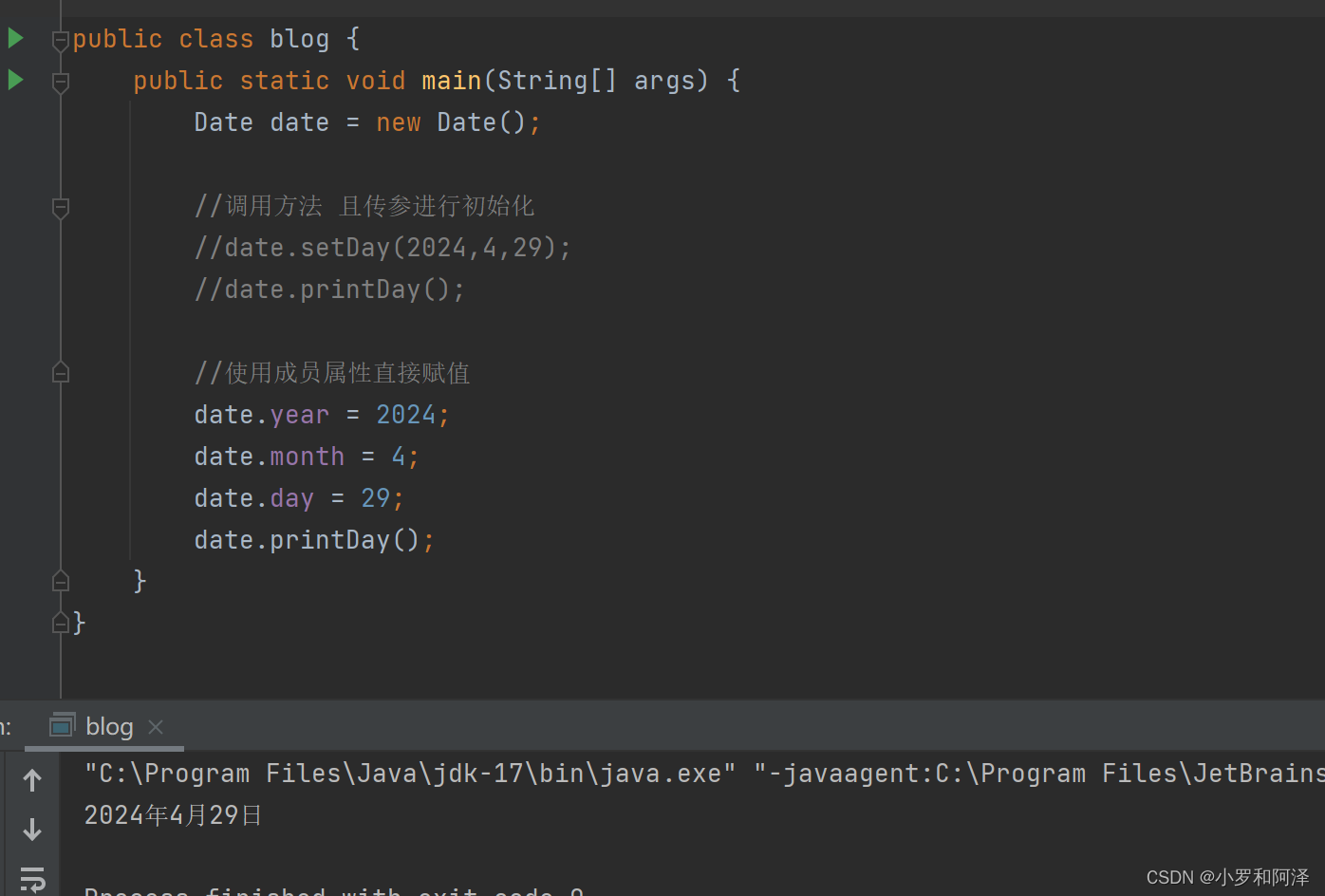
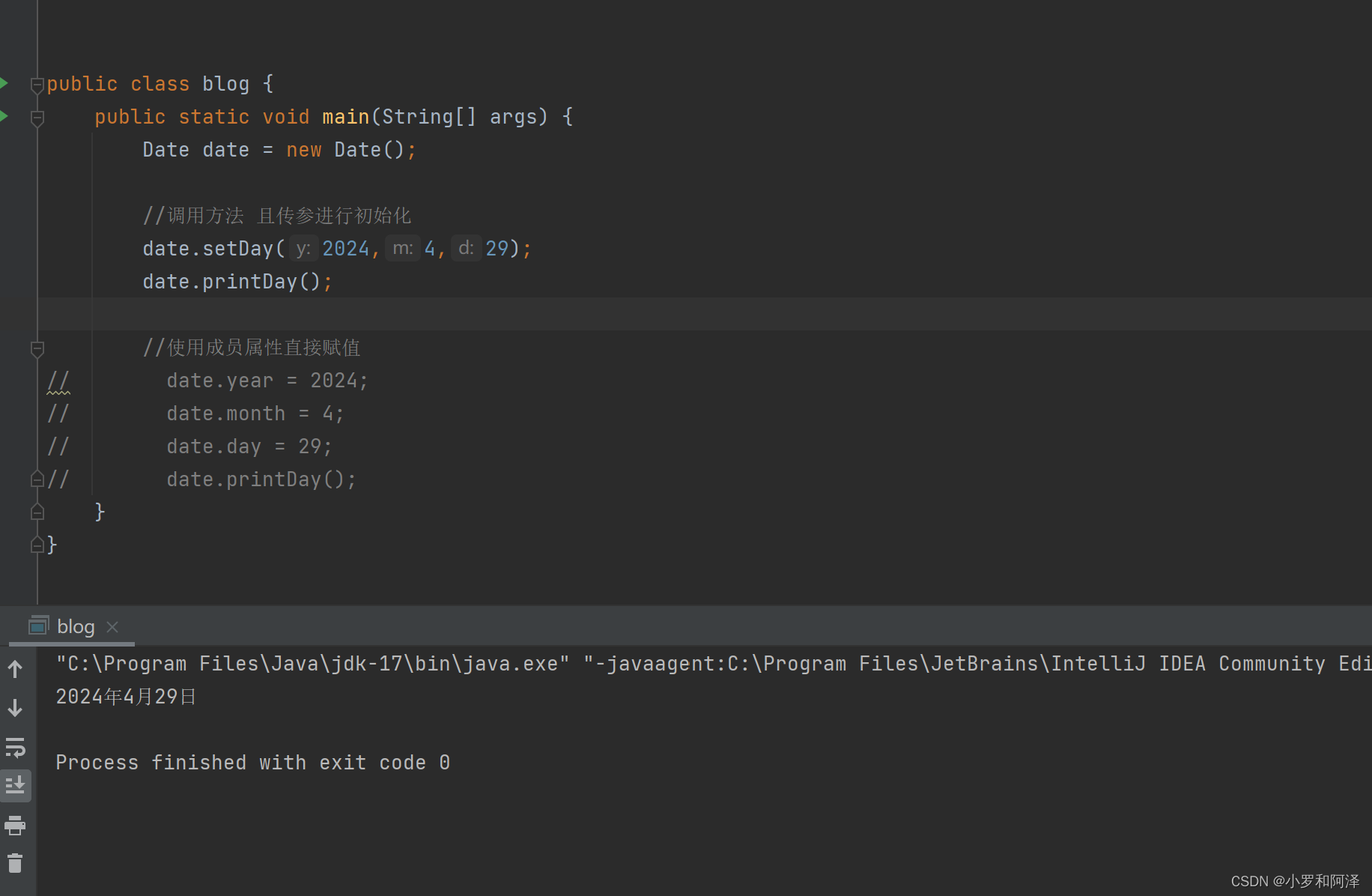
到这里我们就不禁有些疑问,我们有两个对象,但只有一个方法。

我们继续向下看
class Date{
int year;
int month;
int day;
public void setDay(int year,int month,int day){
year = year;
month = month;
day = day;
}
public void printDay(){
System.out.println(year + "年" + month + "月" + day + "日");
}
}
public class blog {
public static void main(String[] args) {
//调用方法 且传参进行初始化
Date date = new Date();
date.setDay(2024,4,29);
date.printDay();
System.out.println("===========================");
//也可以使用成员变量直接赋值
// date.year = 2024;
// date.month = 4;
// date.day = 29;
// date.printDay();
Date date1 = new Date();
date1.setDay(2023,3,30);
date1.printDay();
}
}当我把代码变成这种形式时
public void setDay(int year,int month,int day){
year = year;
month = month;
day = day;
}
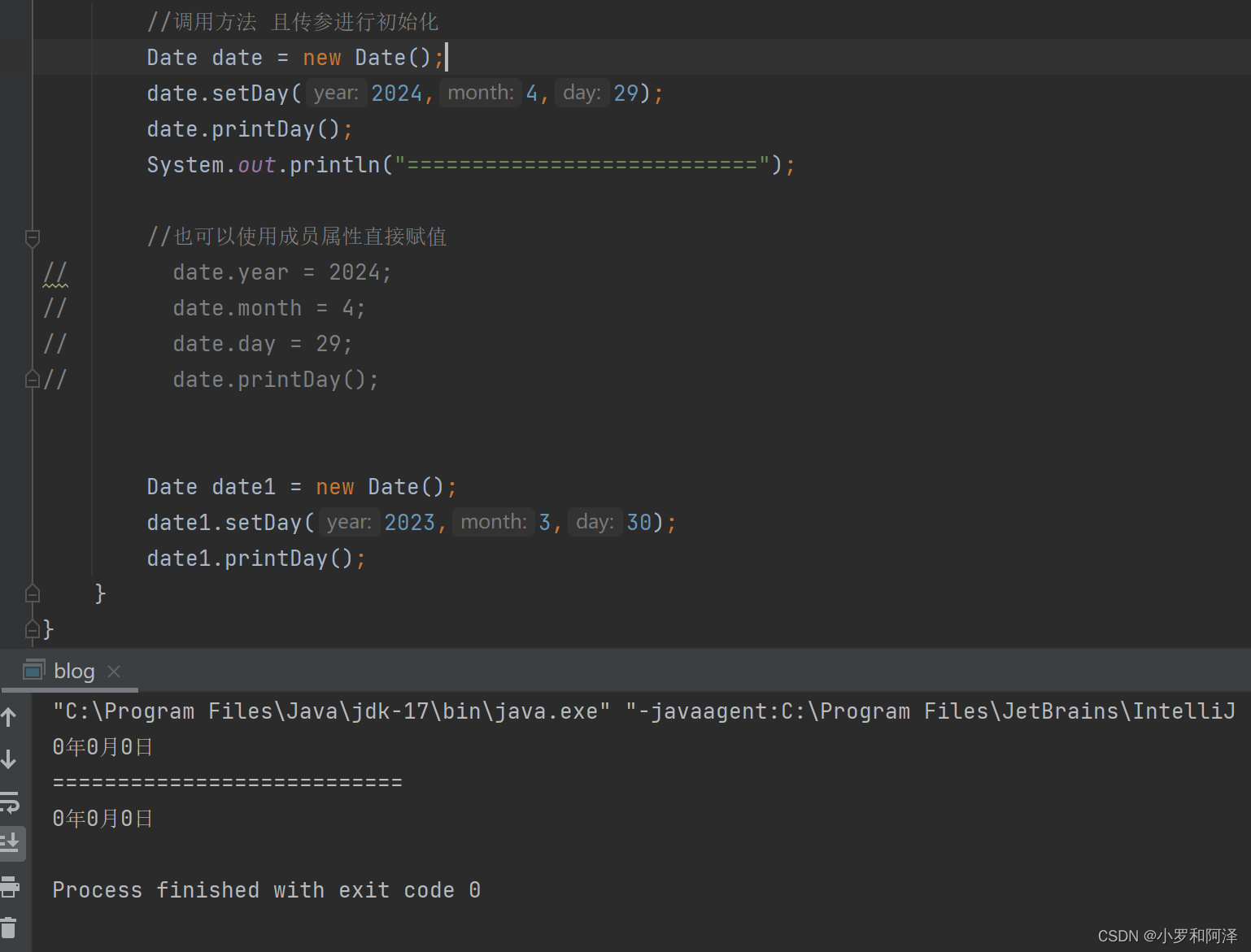 好像计算机也“蒙圈”了
好像计算机也“蒙圈”了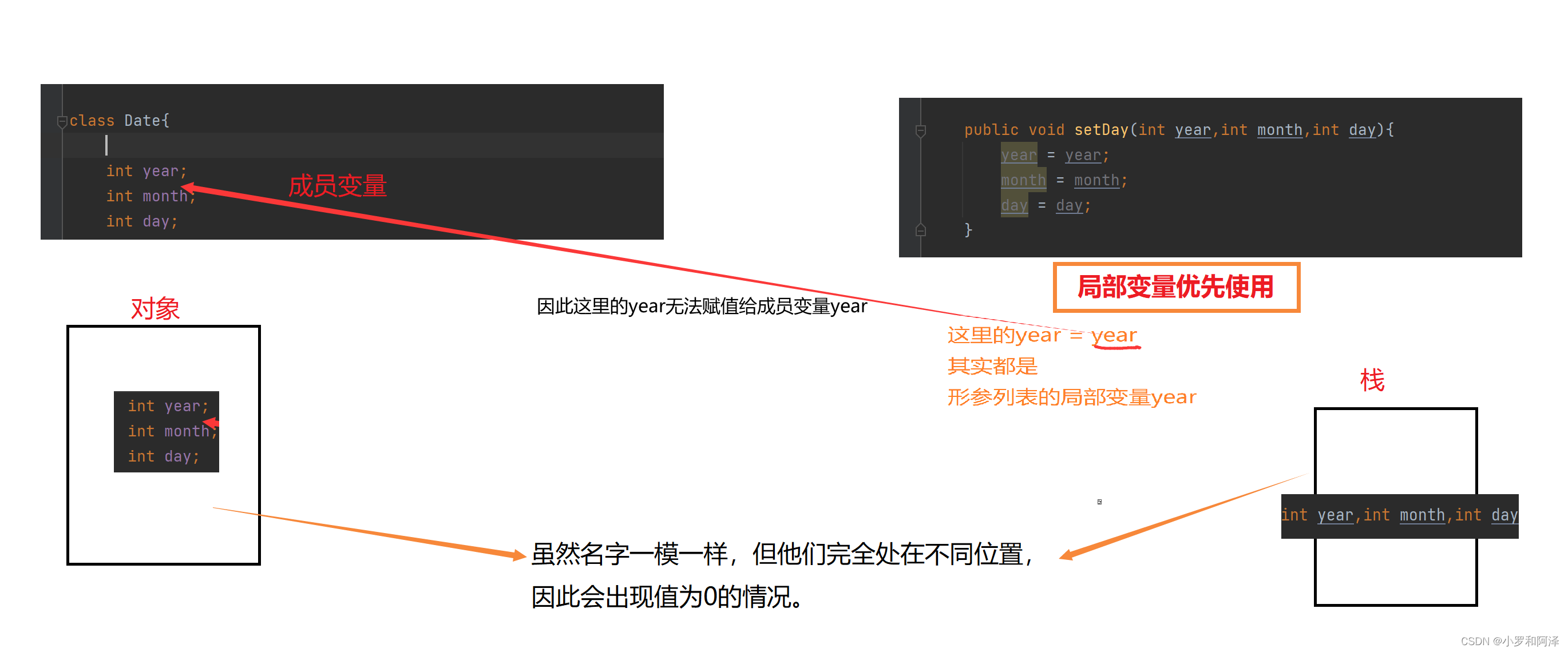
这时我们就需要其他方法来帮助我们,那就是this关键字
1. this
this引用
this 引用指向当前对象 ( 成员方法运行时调用该成员方法的对象 ) ,在成员方法中所有成员变量的操作,都是通过该 引用去访问 。
public void setDay(int year,int month,int day){
this.year = year;
this.month = month;
this.day = day;
}当我们把关键代码修改成上面时,结果是什么样呢?
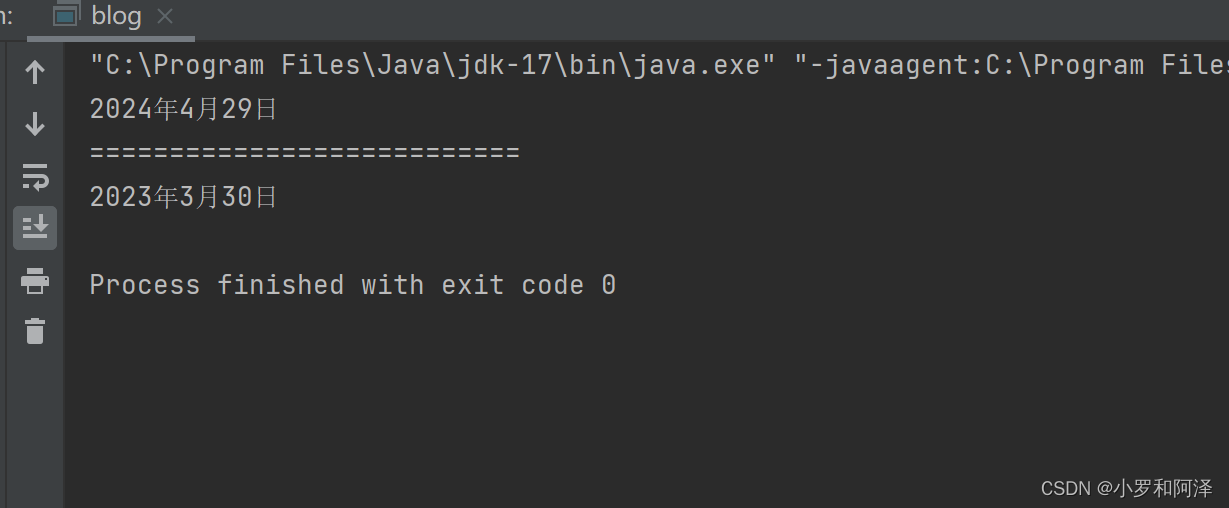 我们可以看到代码又可以正常运行了
我们可以看到代码又可以正常运行了
通俗的来说,哪个 对象引用 调用this,这个this就是其对象引用(简称为“替身”)。
this的特性
1. this的类型:对应类类型引用,即哪个对象调用就是哪个对象的引用类型2. this只能在"成员方法"中使用3. 在"成员方法"中,this只能引用当前对象,不能再引用其他对象4. this是“成员方法”第一个隐藏的参数,编译器会自动传递,在成员方法执行时,编译器会负责将调用成员方法 对象的引用传递给该成员方法,this负责来接收
this的使用
this. 成员变量
this. 成员方法
this()
this()调用的是类中的构造方法,这里先提一下,下面讲构造方法时会解释
2. 对象的构造及初始化
如何初始化对象
在之前的学习中我们知道了,在Java方法内部中定义一个局部变量的时候,一定要初始化。否则会报错
public class NewTest {
public static void main(String[] args) {
int a;
System.out.println(a);
}
}

我们只要把关键代码改为 int a = 10; 就可以正常运行了!
学到这里我们可能就有些疑问?
1. 在之前的代码中成员变量也没有初始化,但为什么没有报错?
class Date{
//成员变量
int year;
int month;
int day;
}因为程序会自动默认给成员变量初始化,引用数据类型的初始值 是 NULL,基本数据类型的初始值是0
class Dog{
String name;
int age;
String color;
public Dog(){
}
public void print(){
System.out.println(this.name + " " + this.age + " " + this.color);
}
}
public class NewTest {
public static void main(String[] args) {
Dog dog = new Dog();
dog.print();
}
}
2. 无论我们是调用方法还是给成员变量赋值,都要去自己重新传一次参或按相应的成员变量一个一个去赋值,好像有点麻烦,有没有什么办法可以直接一次就把成员变量给赋值?
public class blog {
public static void main(String[] args) {
//调用方法 且传参进行初始化
Date date = new Date();
date.setDay(2024,4,29);
date.printDay();
System.out.println("===========================");
//也可以使用成员变量直接赋值
// date.year = 2024;
// date.month = 4;
// date.day = 29;
// date.printDay();
Date date1 = new Date();
date1.setDay(2023,3,30);
date1.printDay();
}
}答案是有的,Ta就是构造方法
构造方法
构造方法(也称为构造器)是一个特殊的成员方法,名字必须与类名相同,在创建对象时,由编译器自动调用,并且在整个对象的生命周期内只调用一次。
语法结构:
访问修饰符 类名 (形参列表){
}
class Date{
int year;
int month;
int day;
//构造方法
public Date(int year, int month, int day){
this.year = year;
this.month = month;
this.day = day;
}
public void setDay(int year,int month,int day){
this.year = year;
this.month = month;
this.day = day;
}
public void printDay(){
System.out.println(year + "年" + month + "月" + day + "日");
}
}
public class blog {
public static void main(String[] args) {
//调用方法 且传参进行初始化
Date date = new Date(2024,4,29);
date.printDay();
System.out.println("===========================");
Date date1 = new Date(2023,3,30);
date1.printDay();
}
}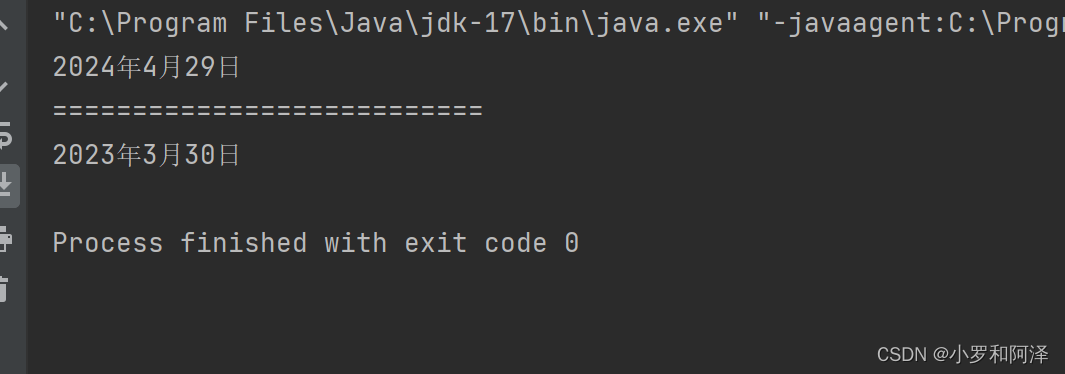
这里我们利用的是构造方法来初始化,而前面的代码我们是利用 setDay方法 来初始化的
构造方法特性:
1. 名字必须与类名相同2. 没有返回值类型,设置为void也不行3. 创建对象时由编译器自动调用,并且在对象的生命周期内只调用一次(相当于人的出生,每个人只能出生一次)4. 构造方法可以重载(用户根据自己的需求提供不同参数的构造方法)
下面的代码中 构造方法就实现了方法的重载
class Date{
//成员属性
int year;
int month;
int day;
//构造方法
public Date(int year) {
this.year = year;
}
//构造方法的重载
public Date(int year, int month) {
this.year = year;
this.month = month;
}
//构造方法的重载
public Date(int yeat, int month, int day){
this.year = year;
this.month = month;
this.day = day;
}
}上述三个构造方法:名字相同,参数列表不同,因此构成了方法重载。
5. 如果用户没有显式定义,编译器会生成一份默认的构造方法,生成的默认构造方法一定是无参的。
注意:一旦用户定义,编译器则不再生成。
6. 构造方法中,可以通过this调用其他构造方法来简化代码
利用构造方法初始化对象的三种方式
方式一
使用无参构造方法,利用this去访问成员变量,并进行赋值
class Dog{
String name;
int age;
String color;
//方式一
public Dog(){
this.name = "小飞";
this.age = 10;
this.color = "粉色";
}
public void print(){
System.out.println(this.name + " " + this.age + " " + this.color);
}
}
public class NewTest {
public static void main(String[] args) {
//方式一
Dog dog = new Dog();
dog.print();
}
}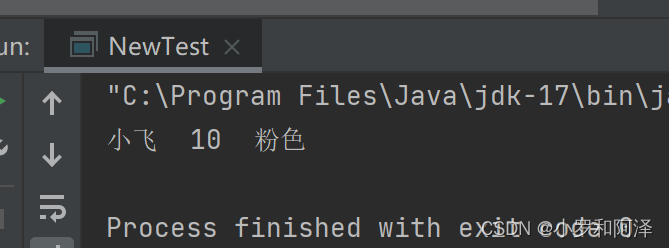
方式二
使用含参数的构造方法,并在创建对象时进行传参,初始化
class Dog{
String name;
int age;
String color;
//方式二
public Dog(String name, int age, String color) {
this.name = name;
this.age = age;
this.color = color;
}
public void print(){
System.out.println(this.name + " " + this.age + " " + this.color);
}
}
public class NewTest {
public static void main(String[] args) {
//方式二
Dog dog1 = new Dog("小飞飞",10,"浅粉色");
dog1.print();
}
}
方式三
先通过 new对象() 调用无参构造方法,再通过 无参构造方法 中的 this(...)语句把其中的参数传给 带参数的构造方法 ,再进行初始化
这里就是前面提到 this() 的知识
this() 就是调用无参的构造方法
this(...) 就是调用对应参数的构造方法
class Dog{
String name;
int age;
String color;
//方式三
public Dog(){
this("小飞飞飞",10,"浅浅粉色");
}
public Dog(String name, int age, String color) {
this.name = name;
this.age = age;
this.color = color;
}
public void print(){
System.out.println(this.name + " " + this.age + " " + this.color);
}
}
public class NewTest {
public static void main(String[] args) {
//方式三
Dog dog = new Dog();
dog.print();
}
}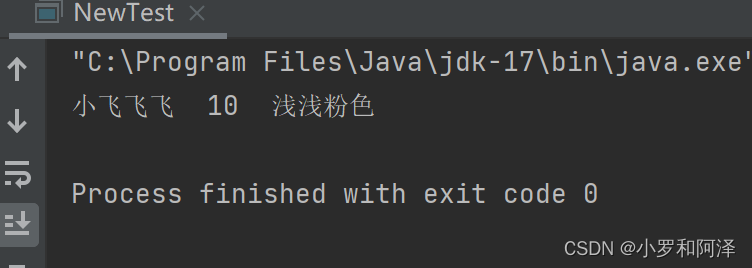
直接初始化
class Dog{
String name = "小狗狗";
int age = 10;
String color = "米白色";
}
























 383
383

 被折叠的 条评论
为什么被折叠?
被折叠的 条评论
为什么被折叠?








